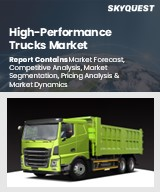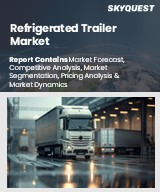
|
시장보고서
상품코드
1511273
세계의 클래스 1 트럭 시장 예측(-2030년) : 제품별, 연료별, 용도별, 최종사용자별, 지역별 전망Class 1 Truck Market Forecasts to 2030 - Global Analysis By Product (Mini Van, Cargo Van, Full-Size Pickup, Step Van and Other Products), Fuel, Application, End User and By Geography |
||||||
Stratistics MRC에 따르면, 세계 클래스 1 트럭 시장은 2024년 1조 8,000억 달러 규모에 이르고, 예측 기간 동안 8.0%의 연평균 복합 성장률(CAGR)로 성장하여 2030년에는 2조 9,000억 달러에 달할 것으로 예상됩니다.
이러한 트럭은 대부분 소형 트럭으로 소형 픽업트럭이나 밴과 같은 차량이 포함됩니다. 클래스 1 트럭은 대형 트럭에 비해 크기와 적재 중량이 상대적으로 작기 때문에 일반적으로 개인 운송 및 경상업용으로 사용됩니다. 다재다능하고 기동성이 뛰어나며 경제적이기 때문에 도시 및 교외 출퇴근, 소규모 배달, 공공 서비스 등 일상 업무에 자주 사용됩니다.
도시화 및 인구 증가
도시화와 인구 증가는 시장 수요 촉진요인입니다. 도시가 확장되고 인구가 증가함에 따라 도시 지역에서의 효율적인 물품 및 서비스 운송에 대한 필요성이 증가하고 있습니다. 1종 트럭은 컴팩트한 크기와 다용도성으로 인해 이러한 환경에서 점점 더 인기를 얻고 있습니다. 1종 트럭은 기동성과 비용 효율성이 뛰어나 혼잡한 도심을 이동하고 급증하는 도시 인구 수요를 충족시키는 데 이상적입니다.
제한된 적재 용량 및 견인력
시장은 적재량과 견인력의 한계라는 큰 문제에 직면해 있습니다. 이러한 제약은 특히 무거운 적재량과 견인력을 필요로 하는 산업에서 다양한 용도에서 트럭의 다양성과 유용성을 제한하고 있습니다. 제조업체들은 규제 표준을 준수하면서 이러한 제약을 극복하기 위해 엔진 성능, 섀시 설계 및 소재의 혁신을 추구하고 있습니다.
소비자 선호도 변화
지속가능성에 대한 관심이 높아지면서 전기차와 하이브리드 자동차에 대한 수요가 증가하고 있습니다. 또한, 내비게이션, 안전, 엔터테인먼트 등 첨단 기술을 우선적으로 구매하게 되면서 효율성과 커넥티비티 기능도 매우 중요해지고 있습니다. 모듈식 디자인과 유연한 인테리어와 같은 커스터마이징 옵션은 산업 전반의 다양한 요구를 충족시키며 인기를 끌고 있습니다. 전반적으로 소비자들은 이 부문에서 환경 친화적이고, 기술적으로 진보적이며, 사용자 정의가 가능한 솔루션을 원하고 있습니다.
연료 가격 변동
최근 몇 년동안 시장은 연료 가격의 급격한 변동을 목격했습니다. 이러한 변동은 지정학적 긴장, 수급 불균형, 규제 변경 등 다양한 요인에 기인합니다. 연료 가격의 변동은 트럭 운송 회사의 운영 비용에 직접적인 영향을 미치고 수익성과 가격 전략에 영향을 미치고 있습니다. 따라서 이 부문의 기업들은 연료 가격 동향을 면밀히 모니터링하고, 이러한 변동에 따른 영향을 줄이기 위해 사업을 조정하는 경우가 많습니다.
COVID-19의 영향 :
주로 소형 트럭으로 구성된 클래스 1 트럭 시장은 코로나19로 인해 여러 가지 영향을 받았습니다. 초기에는 공급망이 끊어지면서 생산과 판매가 둔화되었습니다. 그러나 팬데믹이 진행됨에 따라 전자상거래의 성장에 힘입어 라스트마일 배송 차량에 대한 수요가 급증했습니다. 이에 따라 코로나 이후 지속가능성과 효율성으로의 전환을 반영하여 1등급 트럭에 대한 전기 트럭과 자율주행 트럭에 대한 관심이 높아졌습니다.
예측 기간 동안 화물 밴 부문이 가장 큰 비중을 차지할 것으로 예상됩니다.
예측 기간 동안 화물 밴 부문이 가장 큰 비중을 차지할 것으로 예상됩니다. 다목적성, 연비 효율성, 컴팩트한 크기로 인해 화물 밴은 도심 배송 및 소규모 비즈니스에 적합합니다. 전기 및 하이브리드 기술의 발전과 함께 화물 밴은 환경 친화적으로 변하고 있으며, 이는 환경 친화적인 소비자들에게 어필하고 있습니다. 이러한 변화로 인해 제조업체들은 다양한 산업 및 운송 수요를 충족시키기 위해 클래스 1 부문에서 혁신적인 제품을 제공하게 되었습니다.
농업 부문은 예측 기간 동안 가장 높은 CAGR을 나타낼 것으로 예상됩니다.
농업 분야는 예측 기간 동안 가장 높은 CAGR을 나타낼 것으로 예상됩니다. 소규모 농부들은 효율적인 엔진, 전기 또는 하이브리드 구동계, 스마트 농업 기술과 같은 첨단 기능을 갖춘 친환경 트럭을 선택하고 있습니다. 이러한 트럭은 환경에 미치는 영향을 줄일 뿐만 아니라 농가의 생산성과 운전 편의성을 향상시켜 이 부문에서 농업 관행이 크게 발전하고 있음을 보여줍니다.
가장 큰 점유율을 차지하는 지역 :
북미는 다양한 기능을 갖춘 트럭에 대한 소비자 수요 증가, 연비와 성능 향상으로 이어지는 기술 발전, 자동차와 같은 편안함과 트럭과 같은 실용성을 결합한 크로스오버 차량에 대한 수요 증가 등의 요인으로 인해 예측 기간 동안 가장 큰 시장 점유율을 차지할 것으로 예상됩니다. 또한, 연료 가격 하락, 매력적인 금융 옵션, 경제 호조 등의 요인도 이 지역 시장 성장에 기여하고 있습니다.
CAGR이 가장 높은 지역 :
예측 기간 동안 아시아태평양이 가장 높은 CAGR을 유지할 것으로 예상됩니다. 건설, 물류, 운송 등 다양한 산업에 의해 수요가 촉진되고 있습니다. 이 트럭은 중저중량 상품과 자재를 운반하는 데 사용되며, 기업들에게 필수적인 역할을 하고 있습니다. 이 시장에서의 경쟁은 치열하며, 각 업체들은 경쟁력을 확보하기 위해 제품 혁신, 비용 효율성, 유통망 확장에 주력하고 있습니다.
무료 맞춤형 서비스 :
이 보고서를 구독하는 고객은 다음과 같은 무료 맞춤화 옵션 중 하나를 사용할 수 있습니다.
- 기업 프로파일
- 추가 시장 기업의 종합적인 프로파일링(최대 3개사까지)
- 주요 기업의 SWOT 분석(최대 3개사)
- 지역 세분화
- 고객의 관심에 따른 주요 국가별 시장 추정치, 예측, CAGR(주: 타당성 확인에 따라 다름)
- 경쟁사 벤치마킹
- 제품 포트폴리오, 지리적 입지, 전략적 제휴를 기반으로 한 주요 기업 벤치마킹
목차
제1장 주요 요약
제2장 서문
- 개요
- 이해관계자
- 조사 범위
- 조사 방법
- 데이터 마이닝
- 데이터 분석
- 데이터 검증
- 조사 접근
- 조사 정보원
- 1차 조사 정보원
- 2차 조사 정보원
- 전제조건
제3장 시장 동향 분석
- 성장 촉진요인
- 성장 억제요인
- 기회
- 위협
- 제품 분석
- 용도 분석
- 최종사용자 분석
- 신흥 시장
- COVID-19의 영향
제4장 Porter의 Five Forces 분석
- 공급 기업의 교섭력
- 바이어의 교섭력
- 대체품의 위협
- 신규 진출업체의 위협
- 경쟁 기업간 경쟁 관계
제5장 세계의 클래스 1 트럭 시장 : 제품별
- 미니 밴
- 화물 밴
- 풀 사이즈 픽업
- 스텝 밴
- 기타
제6장 세계의 클래스 1 트럭 시장 : 연료별
- 하이브리드
- 전기
- 디젤
- 가솔린
- 기타
제7장 세계의 클래스 1 트럭 시장 : 용도별
- 도시 배달
- 푸드서비스
- 배송 서비스
- 기타 용도
제8장 세계의 클래스 1 트럭 시장 : 최종사용자별
- 건설
- 농업
- 물류
- 기타
제9장 세계의 클래스 1 트럭 시장 : 지역별
- 북미
- 미국
- 캐나다
- 멕시코
- 유럽
- 독일
- 영국
- 이탈리아
- 프랑스
- 스페인
- 기타 유럽
- 아시아태평양
- 일본
- 중국
- 인도
- 호주
- 뉴질랜드
- 한국
- 기타 아시아태평양
- 남미
- 아르헨티나
- 브라질
- 칠레
- 기타 남미
- 중동 및 아프리카
- 사우디아라비아
- 아랍에미리트(UAE)
- 카타르
- 남아프리카공화국
- 기타 중동 및 아프리카
제10장 주요 발전
- 계약/파트너십/협업/합작투자(JV)
- 인수와 합병
- 신제품 발매
- 사업 확대
- 기타 주요 전략
제11장 기업 프로파일링
- Volvo Trucks
- Mercedes-Benz Trucks
- Tata Motors Limited
- Mahindra & Mahindra Limited
- Ashok Leyland
- Hyundai Motor Company
- Nissan
- Ford Motor Company
- General Motors
- Chevrolet
- Isuzu Motors Limited
- Freightliner
- JAC Motors
- Ram Trucks
- Hino Motors
LSH 24.07.19
According to Stratistics MRC, the Global Class 1 Truck Market is accounted for $1.8 trillion in 2024 and is expected to reach $2.9 trillion by 2030 growing at a CAGR of 8.0% during the forecast period. These trucks are often light-duty and include vehicles like small pickup trucks and vans. Class 1 trucks are typically used for personal transportation or light commercial purposes due to their relatively smaller size and weight capacity compared to larger classes of trucks. They are versatile, maneuverable, and economical, making them popular choices for everyday tasks such as commuting, small-scale deliveries, and utility services in urban and suburban environments.
Market Dynamics:
Driver:
Urbanization and population growth
Urbanization and population growth are key drivers of demand in the market. As cities expand and populations increase, there's a growing need for efficient transportation of goods and services within urban areas. Class 1 Trucks, with their compact size and versatility, are becoming increasingly popular in these settings. They offer maneuverability and cost-effectiveness, making them ideal for navigating crowded city streets and meeting the demands of a burgeoning urban population.
Restraint:
Limited payload and towing capacity
The market faces a significant challenge with limited payload and towing capacity. This constraint restricts the versatility and utility of these trucks for various applications, especially in industries requiring heavier loads or towing capabilities. Manufacturers are pressured to innovate in engine performance, chassis design, and materials to overcome these limitations while complying with regulatory standards.
Opportunity:
Evolving consumer preferences
There's a growing demand for electric and hybrid options as sustainability gains importance. Efficiency and connectivity features are also becoming crucial, with buyers prioritizing advanced technology for navigation, safety, and entertainment. Customization options, such as modular designs and flexible interiors, are gaining traction, catering to diverse needs across industries. Overall, consumers are seeking eco-friendly, technologically advanced, and customizable solutions in the segment.
Threat:
Fuel price fluctuations
The market has witnessed significant fuel price fluctuations in recent years. These fluctuations can be attributed to various factors such as geopolitical tensions, supply and demand imbalances, and regulatory changes. The volatility in fuel prices has had a direct impact on operating costs for trucking companies, influencing their profitability and pricing strategies. As a result, businesses in this sector closely monitor fuel price trends and often adapt their operations to mitigate the effects of these fluctuations.
Covid-19 Impact:
The Class 1 truck market, primarily comprising light-duty trucks, witnessed several effects due to COVID-19. Initially, there was a slowdown in production and sales as supply chains were disrupted. However, as the pandemic progressed, demand surged for last-mile delivery vehicles, driven by e-commerce growth. This led to increased interest in electric and autonomous Class 1 trucks, reflecting a shift towards sustainability and efficiency post-COVID.
The cargo van segment is expected to be the largest during the forecast period
The cargo van segment is expected to be the largest during the forecast period. Their versatility, fuel efficiency, and compact size make them ideal for urban deliveries and small businesses. With advancements in electric and hybrid technology, cargo vans are also becoming more eco-friendly, appealing to environmentally conscious consumers. This shift has prompted manufacturers to innovate and expand their offerings in the Class 1 segment, catering to a diverse range of industries and transportation needs.
The agriculture segment is expected to have the highest CAGR during the forecast period
The agriculture segment is expected to have the highest CAGR during the forecast period. Small-scale farmers are increasingly opting for eco-friendly trucks equipped with advanced features like efficient engines, electric or hybrid drivetrains, and smart farming technologies. These trucks not only reduce environmental impact but also enhance productivity and operational convenience for farmers, marking a significant evolution in agricultural practices within the segment.
Region with largest share:
North America is projected to hold the largest market share during the forecast period driven by factors such as increasing consumer demand for trucks with versatile capabilities, advancements in technology leading to improved fuel efficiency and performance, and a trend towards crossover vehicles that offer a blend of car-like comfort and truck-like utility. Additionally, factors such as lower fuel prices, attractive financing options, and a strong economy have also contributed to the growth of the market in the region.
Region with highest CAGR:
Asia Pacific is projected to hold the highest CAGR over the forecast period. The demand is fueled by various industries such as construction, logistics, and transportation. These trucks are used for carrying light to medium-weight goods and materials, making them essential for businesses. Competition in this market is intense, with companies focusing on product innovation, cost-efficiency, and expanding their distribution networks to gain a competitive edge.
Key players in the market
Some of the key players in Class 1 Truck market include Volvo Trucks, Mercedes-Benz Trucks, Tata Motors Limited, Mahindra & Mahindra Limited, Ashok Leyland, Hyundai Motor Company, Nissan, Ford Motor Company, General Motors, Chevrolet, Isuzu Motors Limited, Freightliner, JAC Motors, Ram Trucks and Hino Motors.
Key Developments:
In March 2024, Nissan Motor and Honda Motor announced that they had agreed to begin talks on a potential strategic partnership to collaborate on electric vehicles and automotive software, at a time when the two conventional carmakers are facing stiff competition from market newcomers.
In May 2023, Isuzu and Honda announced a partnership to develop and supply a fuel cell system for a heavy-duty truck that Isuzu plans to release in 2027.
Products Covered:
- Mini Van
- Cargo Van
- Full-Size Pickup
- Step Van
- Other Products
Fuels Covered:
- Hybrid
- Electric
- Diesel
- Gasoline
- Other Fuels
Applications Covered:
- Urban Delivery
- Food Service
- Delivery Services
- Other Applications
End Users Covered:
- Construction
- Agriculture
- Logistics
Regions Covered:
- North America
- US
- Canada
- Mexico
- Europe
- Germany
- UK
- Italy
- France
- Spain
- Rest of Europe
- Asia Pacific
- Japan
- China
- India
- Australia
- New Zealand
- South Korea
- Rest of Asia Pacific
- South America
- Argentina
- Brazil
- Chile
- Rest of South America
- Middle East & Africa
- Saudi Arabia
- UAE
- Qatar
- South Africa
- Rest of Middle East & Africa
What our report offers:
- Market share assessments for the regional and country-level segments
- Strategic recommendations for the new entrants
- Covers Market data for the years 2022, 2023, 2024, 2026, and 2030
- Market Trends (Drivers, Constraints, Opportunities, Threats, Challenges, Investment Opportunities, and recommendations)
- Strategic recommendations in key business segments based on the market estimations
- Competitive landscaping mapping the key common trends
- Company profiling with detailed strategies, financials, and recent developments
- Supply chain trends mapping the latest technological advancements
Free Customization Offerings:
All the customers of this report will be entitled to receive one of the following free customization options:
- Company Profiling
- Comprehensive profiling of additional market players (up to 3)
- SWOT Analysis of key players (up to 3)
- Regional Segmentation
- Market estimations, Forecasts and CAGR of any prominent country as per the client's interest (Note: Depends on feasibility check)
- Competitive Benchmarking
- Benchmarking of key players based on product portfolio, geographical presence, and strategic alliances
Table of Contents
1 Executive Summary
2 Preface
- 2.1 Abstract
- 2.2 Stake Holders
- 2.3 Research Scope
- 2.4 Research Methodology
- 2.4.1 Data Mining
- 2.4.2 Data Analysis
- 2.4.3 Data Validation
- 2.4.4 Research Approach
- 2.5 Research Sources
- 2.5.1 Primary Research Sources
- 2.5.2 Secondary Research Sources
- 2.5.3 Assumptions
3 Market Trend Analysis
- 3.1 Introduction
- 3.2 Drivers
- 3.3 Restraints
- 3.4 Opportunities
- 3.5 Threats
- 3.6 Product Analysis
- 3.7 Application Analysis
- 3.8 End User Analysis
- 3.9 Emerging Markets
- 3.10 Impact of Covid-19
4 Porters Five Force Analysis
- 4.1 Bargaining power of suppliers
- 4.2 Bargaining power of buyers
- 4.3 Threat of substitutes
- 4.4 Threat of new entrants
- 4.5 Competitive rivalry
5 Global Class 1 Truck Market, By Product
- 5.1 Introduction
- 5.2 Mini Van
- 5.3 Cargo Van
- 5.4 Full-Size Pickup
- 5.5 Step Van
- 5.6 Other Products
6 Global Class 1 Truck Market, By Fuel
- 6.1 Introduction
- 6.2 Hybrid
- 6.3 Electric
- 6.4 Diesel
- 6.5 Gasoline
- 6.6 Other Fuels
7 Global Class 1 Truck Market, By Application
- 7.1 Introduction
- 7.2 Urban Delivery
- 7.3 Food Service
- 7.4 Delivery Services
- 7.5 Other Applications
8 Global Class 1 Truck Market, By End User
- 8.1 Introduction
- 8.2 Construction
- 8.3 Agriculture
- 8.4 Logistics
- 8.5 Other End Users
9 Global Class 1 Truck Market, By Geography
- 9.1 Introduction
- 9.2 North America
- 9.2.1 US
- 9.2.2 Canada
- 9.2.3 Mexico
- 9.3 Europe
- 9.3.1 Germany
- 9.3.2 UK
- 9.3.3 Italy
- 9.3.4 France
- 9.3.5 Spain
- 9.3.6 Rest of Europe
- 9.4 Asia Pacific
- 9.4.1 Japan
- 9.4.2 China
- 9.4.3 India
- 9.4.4 Australia
- 9.4.5 New Zealand
- 9.4.6 South Korea
- 9.4.7 Rest of Asia Pacific
- 9.5 South America
- 9.5.1 Argentina
- 9.5.2 Brazil
- 9.5.3 Chile
- 9.5.4 Rest of South America
- 9.6 Middle East & Africa
- 9.6.1 Saudi Arabia
- 9.6.2 UAE
- 9.6.3 Qatar
- 9.6.4 South Africa
- 9.6.5 Rest of Middle East & Africa
10 Key Developments
- 10.1 Agreements, Partnerships, Collaborations and Joint Ventures
- 10.2 Acquisitions & Mergers
- 10.3 New Product Launch
- 10.4 Expansions
- 10.5 Other Key Strategies
11 Company Profiling
- 11.1 Volvo Trucks
- 11.2 Mercedes-Benz Trucks
- 11.3 Tata Motors Limited
- 11.4 Mahindra & Mahindra Limited
- 11.5 Ashok Leyland
- 11.6 Hyundai Motor Company
- 11.7 Nissan
- 11.8 Ford Motor Company
- 11.9 General Motors
- 11.10 Chevrolet
- 11.11 Isuzu Motors Limited
- 11.12 Freightliner
- 11.13 JAC Motors
- 11.14 Ram Trucks
- 11.15 Hino Motors
- 추가 시장 기업의 종합적인 프로파일링(최대 3개사까지)
- 주요 기업의 SWOT 분석(최대 3개사)
- 고객의 관심에 따른 주요 국가별 시장 추정치, 예측, CAGR(주: 타당성 확인에 따라 다름)
- 제품 포트폴리오, 지리적 입지, 전략적 제휴를 기반으로 한 주요 기업 벤치마킹
- 데이터 마이닝
- 데이터 분석
- 데이터 검증
- 조사 접근
- 1차 조사 정보원
- 2차 조사 정보원
- 전제조건
- 미국
- 캐나다
- 멕시코
- 독일
- 영국
- 이탈리아
- 프랑스
- 스페인
- 기타 유럽
- 일본
- 중국
- 인도
- 호주
- 뉴질랜드
- 한국
- 기타 아시아태평양
- 아르헨티나
- 브라질
- 칠레
- 기타 남미
- 사우디아라비아
- 아랍에미리트(UAE)
- 카타르
- 남아프리카공화국
- 기타 중동 및 아프리카
According to Stratistics MRC, the Global Class 1 Truck Market is accounted for $1.8 trillion in 2024 and is expected to reach $2.9 trillion by 2030 growing at a CAGR of 8.0% during the forecast period. These trucks are often light-duty and include vehicles like small pickup trucks and vans. Class 1 trucks are typically used for personal transportation or light commercial purposes due to their relatively smaller size and weight capacity compared to larger classes of trucks. They are versatile, maneuverable, and economical, making them popular choices for everyday tasks such as commuting, small-scale deliveries, and utility services in urban and suburban environments.
Market Dynamics:
Driver:
Urbanization and population growth
Urbanization and population growth are key drivers of demand in the market. As cities expand and populations increase, there's a growing need for efficient transportation of goods and services within urban areas. Class 1 Trucks, with their compact size and versatility, are becoming increasingly popular in these settings. They offer maneuverability and cost-effectiveness, making them ideal for navigating crowded city streets and meeting the demands of a burgeoning urban population.
Restraint:
Limited payload and towing capacity
The market faces a significant challenge with limited payload and towing capacity. This constraint restricts the versatility and utility of these trucks for various applications, especially in industries requiring heavier loads or towing capabilities. Manufacturers are pressured to innovate in engine performance, chassis design, and materials to overcome these limitations while complying with regulatory standards.
Opportunity:
Evolving consumer preferences
There's a growing demand for electric and hybrid options as sustainability gains importance. Efficiency and connectivity features are also becoming crucial, with buyers prioritizing advanced technology for navigation, safety, and entertainment. Customization options, such as modular designs and flexible interiors, are gaining traction, catering to diverse needs across industries. Overall, consumers are seeking eco-friendly, technologically advanced, and customizable solutions in the segment.
Threat:
Fuel price fluctuations
The market has witnessed significant fuel price fluctuations in recent years. These fluctuations can be attributed to various factors such as geopolitical tensions, supply and demand imbalances, and regulatory changes. The volatility in fuel prices has had a direct impact on operating costs for trucking companies, influencing their profitability and pricing strategies. As a result, businesses in this sector closely monitor fuel price trends and often adapt their operations to mitigate the effects of these fluctuations.
Covid-19 Impact:
The Class 1 truck market, primarily comprising light-duty trucks, witnessed several effects due to COVID-19. Initially, there was a slowdown in production and sales as supply chains were disrupted. However, as the pandemic progressed, demand surged for last-mile delivery vehicles, driven by e-commerce growth. This led to increased interest in electric and autonomous Class 1 trucks, reflecting a shift towards sustainability and efficiency post-COVID.
The cargo van segment is expected to be the largest during the forecast period
The cargo van segment is expected to be the largest during the forecast period. Their versatility, fuel efficiency, and compact size make them ideal for urban deliveries and small businesses. With advancements in electric and hybrid technology, cargo vans are also becoming more eco-friendly, appealing to environmentally conscious consumers. This shift has prompted manufacturers to innovate and expand their offerings in the Class 1 segment, catering to a diverse range of industries and transportation needs.
The agriculture segment is expected to have the highest CAGR during the forecast period
The agriculture segment is expected to have the highest CAGR during the forecast period. Small-scale farmers are increasingly opting for eco-friendly trucks equipped with advanced features like efficient engines, electric or hybrid drivetrains, and smart farming technologies. These trucks not only reduce environmental impact but also enhance productivity and operational convenience for farmers, marking a significant evolution in agricultural practices within the segment.
Region with largest share:
North America is projected to hold the largest market share during the forecast period driven by factors such as increasing consumer demand for trucks with versatile capabilities, advancements in technology leading to improved fuel efficiency and performance, and a trend towards crossover vehicles that offer a blend of car-like comfort and truck-like utility. Additionally, factors such as lower fuel prices, attractive financing options, and a strong economy have also contributed to the growth of the market in the region.
Region with highest CAGR:
Asia Pacific is projected to hold the highest CAGR over the forecast period. The demand is fueled by various industries such as construction, logistics, and transportation. These trucks are used for carrying light to medium-weight goods and materials, making them essential for businesses. Competition in this market is intense, with companies focusing on product innovation, cost-efficiency, and expanding their distribution networks to gain a competitive edge.
Key players in the market
Some of the key players in Class 1 Truck market include Volvo Trucks, Mercedes-Benz Trucks, Tata Motors Limited, Mahindra & Mahindra Limited, Ashok Leyland, Hyundai Motor Company, Nissan, Ford Motor Company, General Motors, Chevrolet, Isuzu Motors Limited, Freightliner, JAC Motors, Ram Trucks and Hino Motors.
Key Developments:
In March 2024, Nissan Motor and Honda Motor announced that they had agreed to begin talks on a potential strategic partnership to collaborate on electric vehicles and automotive software, at a time when the two conventional carmakers are facing stiff competition from market newcomers.
In May 2023, Isuzu and Honda announced a partnership to develop and supply a fuel cell system for a heavy-duty truck that Isuzu plans to release in 2027.
Products Covered:
- Mini Van
- Cargo Van
- Full-Size Pickup
- Step Van
- Other Products
Fuels Covered:
- Hybrid
- Electric
- Diesel
- Gasoline
- Other Fuels
Applications Covered:
- Urban Delivery
- Food Service
- Delivery Services
- Other Applications
End Users Covered:
- Construction
- Agriculture
- Logistics
Regions Covered:
- North America
- US
- Canada
- Mexico
- Europe
- Germany
- UK
- Italy
- France
- Spain
- Rest of Europe
- Asia Pacific
- Japan
- China
- India
- Australia
- New Zealand
- South Korea
- Rest of Asia Pacific
- South America
- Argentina
- Brazil
- Chile
- Rest of South America
- Middle East & Africa
- Saudi Arabia
- UAE
- Qatar
- South Africa
- Rest of Middle East & Africa
What our report offers:
- Market share assessments for the regional and country-level segments
- Strategic recommendations for the new entrants
- Covers Market data for the years 2022, 2023, 2024, 2026, and 2030
- Market Trends (Drivers, Constraints, Opportunities, Threats, Challenges, Investment Opportunities, and recommendations)
- Strategic recommendations in key business segments based on the market estimations
- Competitive landscaping mapping the key common trends
- Company profiling with detailed strategies, financials, and recent developments
- Supply chain trends mapping the latest technological advancements
Free Customization Offerings:
All the customers of this report will be entitled to receive one of the following free customization options:
- Company Profiling
- Comprehensive profiling of additional market players (up to 3)
- SWOT Analysis of key players (up to 3)
- Regional Segmentation
- Market estimations, Forecasts and CAGR of any prominent country as per the client's interest (Note: Depends on feasibility check)
- Competitive Benchmarking
- Benchmarking of key players based on product portfolio, geographical presence, and strategic alliances
Table of Contents
1 Executive Summary
2 Preface
- 2.1 Abstract
- 2.2 Stake Holders
- 2.3 Research Scope
- 2.4 Research Methodology
- 2.4.1 Data Mining
- 2.4.2 Data Analysis
- 2.4.3 Data Validation
- 2.4.4 Research Approach
- 2.5 Research Sources
- 2.5.1 Primary Research Sources
- 2.5.2 Secondary Research Sources
- 2.5.3 Assumptions
3 Market Trend Analysis
- 3.1 Introduction
- 3.2 Drivers
- 3.3 Restraints
- 3.4 Opportunities
- 3.5 Threats
- 3.6 Product Analysis
- 3.7 Application Analysis
- 3.8 End User Analysis
- 3.9 Emerging Markets
- 3.10 Impact of Covid-19
4 Porters Five Force Analysis
- 4.1 Bargaining power of suppliers
- 4.2 Bargaining power of buyers
- 4.3 Threat of substitutes
- 4.4 Threat of new entrants
- 4.5 Competitive rivalry
5 Global Class 1 Truck Market, By Product
- 5.1 Introduction
- 5.2 Mini Van
- 5.3 Cargo Van
- 5.4 Full-Size Pickup
- 5.5 Step Van
- 5.6 Other Products
6 Global Class 1 Truck Market, By Fuel
- 6.1 Introduction
- 6.2 Hybrid
- 6.3 Electric
- 6.4 Diesel
- 6.5 Gasoline
- 6.6 Other Fuels
7 Global Class 1 Truck Market, By Application
- 7.1 Introduction
- 7.2 Urban Delivery
- 7.3 Food Service
- 7.4 Delivery Services
- 7.5 Other Applications
8 Global Class 1 Truck Market, By End User
- 8.1 Introduction
- 8.2 Construction
- 8.3 Agriculture
- 8.4 Logistics
- 8.5 Other End Users
9 Global Class 1 Truck Market, By Geography
- 9.1 Introduction
- 9.2 North America
- 9.2.1 US
- 9.2.2 Canada
- 9.2.3 Mexico
- 9.3 Europe
- 9.3.1 Germany
- 9.3.2 UK
- 9.3.3 Italy
- 9.3.4 France
- 9.3.5 Spain
- 9.3.6 Rest of Europe
- 9.4 Asia Pacific
- 9.4.1 Japan
- 9.4.2 China
- 9.4.3 India
- 9.4.4 Australia
- 9.4.5 New Zealand
- 9.4.6 South Korea
- 9.4.7 Rest of Asia Pacific
- 9.5 South America
- 9.5.1 Argentina
- 9.5.2 Brazil
- 9.5.3 Chile
- 9.5.4 Rest of South America
- 9.6 Middle East & Africa
- 9.6.1 Saudi Arabia
- 9.6.2 UAE
- 9.6.3 Qatar
- 9.6.4 South Africa
- 9.6.5 Rest of Middle East & Africa
10 Key Developments
- 10.1 Agreements, Partnerships, Collaborations and Joint Ventures
- 10.2 Acquisitions & Mergers
- 10.3 New Product Launch
- 10.4 Expansions
- 10.5 Other Key Strategies
11 Company Profiling
- 11.1 Volvo Trucks
- 11.2 Mercedes-Benz Trucks
- 11.3 Tata Motors Limited
- 11.4 Mahindra & Mahindra Limited
- 11.5 Ashok Leyland
- 11.6 Hyundai Motor Company
- 11.7 Nissan
- 11.8 Ford Motor Company
- 11.9 General Motors
- 11.10 Chevrolet
- 11.11 Isuzu Motors Limited
- 11.12 Freightliner
- 11.13 JAC Motors
- 11.14 Ram Trucks
- 11.15 Hino Motors



















